Validation of a Large-Eddy Simulation Approach for Prediction of the Ground Roughness Influence on Wind Turbine Wakes
Abstract
:1. Background and Motivation
1.1. Previous Work
1.2. Goals and Structure of the Paper
2. Numerical Simulation Approach
2.1. Flow Solver INCA
2.2. Wall Modeling Methodology
2.2.1. Standard Wall-Stress Model
2.2.2. Assessment of the Standard Wall Model
2.2.3. Grid Resolution Sensitivity
2.2.4. Virtually Lifted-Wall Stress Model
2.3. Actuator Line Modeling of the Rotor
2.4. Blade Polar Identification
2.5. Set-Up of the Full LES Simulation
2.5.1. Boundary Conditions
2.5.2. Parameters of Investigated Cases
3. Comparison of LES Results with Measurements
3.1. Flow Evolution in the Empty Domain
3.2. Rotor Performance
3.3. Flow Field in the Wake Region
4. Summary and Conclusions
- In the fully coupled simulation approach, turbulent inflow is generated by an internal mapping approach (recycling technique) in an upstream segment of the computational domain with coarser grid resolution. Changes in the grid spacing significantly affect the axial evolution of turbulence intensities in case .
- The rough wall is approximated via a relation between instantaneous wall-shear stress and the tangential velocity at an off-wall position . In accordance with [29], a better match with the logarithmic law of the wall is achieved when is chosen at least three cell layers away from the ground.
- For moderate roughness (), shear exponent, turbulence intensities and spectral densities of the approach flow match well with measurements in the lower half of the boundary layer.
- For high roughness (), a novel wall-model (virtually lifted wall) [14] was used: in this case, the match with the measured inflow is good at hub height, although not over the entire boundary layer.
- Erroneous values of turbulence intensities in wall-adjacent cell layers resulting from short-comings of the wall-stress model do not adversely affect the wake evolution.
- Actuator line (ALM) rotor modeling works best if the blade polar identification is based on an inverted blade element momentum theory in conjunction with 3D-RANS simulation of the blade geometry of the wind turbine model.
- In the near wake (), the mean flow matches well, whereas turbulence intensities in the LES do not reach the same maxima associated with the formation and break-down of tip vortices as the experimental data, probably due to limitations of the ALM method.
- In the far wake, , lateral profiles of mean flow, Reynolds shear stresses and turbulence intensities in a wall-parallel plane at hub height match better with measurements then profiles in a vertical plane through the wake center.
- An axial shift in the wake deficit is associated with overprediction of the wake depth. Nevertheless, the change rates are well reproduced. Whereas the influence of roughness on the vertical wake deflection is well captured, its impact on the wake width is larger in the LES than in the reference experiment.
- The remaining differences between simulation and measurements can not be tracked down to a single cause; they can be interpreted as a limit for the achievable accuracy with the current approach.
Author Contributions
Funding
Data Availability Statement
Acknowledgments
Conflicts of Interest
References
- Knudsen, T.; Bak, T.; Svenstrup, M. Survey of wind farm control—Power and fatigue optimization. Wind Energy 2015, 18, 1333–1351. [Google Scholar] [CrossRef]
- Abkar, M.; Porté-Agel, F. Influence of atmospheric stability on wind-turbine wakes: A large-eddy simulation study. Phys. Fluids 2015, 27, 035104. [Google Scholar] [CrossRef] [Green Version]
- Vollmer, L.; Steinfeld, G. Estimating the wake deflection downstream of a wind turbine in different atmospheric stabilities: An LES study. Wind Energ. Sci. 2016, 1, 129–141. [Google Scholar] [CrossRef] [Green Version]
- Hsieh, A.S.; Brown, K.A.; deVelder, N.B.; Herges, T.G.; Knaus, R.C. High-fidelity wind farm simulation methodology with experimental validation. J. Wind. Eng. Ind. Aerodyn. 2021, 218, 104754. [Google Scholar] [CrossRef]
- Vermeer, L.; Sørensen, J.; Crespo, A. Wind turbine wake aerodynamics. Prog. Aerosp. Sci. 2003, 39, 467–510. [Google Scholar] [CrossRef]
- Porté-Agel, F.; Bastankhah, M.; Shamsoddin, S. Wind-Turbine and Wind-Farm Flows: A Review. Bound.-Layer Meteorol. 2020, 174, 1–59. [Google Scholar] [CrossRef] [Green Version]
- Sørensen, J.; Mikkelsen, R.F.; Henningson, D.S.; Ivanell, S.; Sarmast, S.; Andersen, S.J. Simulation of wind turbine wakes using the actuator line technique. Philos. Trans. R. Soc. A Math. Phys. Eng. Sci. 2015, 373, 20140071. [Google Scholar] [CrossRef] [Green Version]
- Barlas, E.; Buckingham, S.; van Beeck, J. Roughness Effects on Wind-Turbine Wake Dynamics in a Boundary-Layer Wind Tunnel. Bound.-Layer Meteorol. 2016, 158, 27–42. [Google Scholar] [CrossRef] [Green Version]
- Zhang, W.; Markfort, C.; Porté-Agel, F. Near-wake flow structure downwind of a wind turbine in a turbulent boundary layer. Exp. Fluids 2011, 52, 1219–1235. [Google Scholar] [CrossRef] [Green Version]
- Chamorro, L.; Porté-Agel, F. A Wind-Tunnel Investigation of Wind-Turbine Wakes: Boundary-Layer Turbulence Effects. Bound.-Layer Meteorol. 2009, 132, 129–149. [Google Scholar] [CrossRef] [Green Version]
- Wu, Y.; Porté-Agel, F. Atmospheric Turbulence Effects on Wind-Turbine Wakes: An LES Study. Energies 2012, 5, 5340–5362. [Google Scholar] [CrossRef]
- Jin, Y. Effects of Freestream Turbulence in a Model Wind Turbine Wake. Energies 2016, 9, 830. [Google Scholar] [CrossRef] [Green Version]
- ESDU. Engineering Sciences Data Unit. Characteristics of Atmospheric Turbulence Near the Ground; Part II: Single Point Data for Strong Winds (Neutral Atmosphere); ESDU International, Item No. 85020; ESDU: London, UK, 2001; ISBN 978-0-85679-526-7. [Google Scholar]
- Stein, V. Analysis of Wind Turbine Wakes Immersed in Turbulent Boundary Layer Flows over Rough Surfaces-An Experimental and Numerical Study. Ph.D. Thesis, Technical University Munich, München, Germany, 2022. [Google Scholar]
- Stein, V.; Kaltenbach, H.J. Non-Equilibrium Scaling Applied to the Wake Evolution of a Model Scale Wind Turbine. Energies 2019, 12, 2763. [Google Scholar] [CrossRef] [Green Version]
- Counihan, J. An improved method of simulating an atmospheric boundary layer in a wind tunnel. Atmos. Environ. 1969, 3, 197–214. [Google Scholar] [CrossRef]
- Sørensen, J.; Myken, A. Unsteady actuator disc model for horizontal axis wind turbines. J. Wind. Eng. Ind. Aerodyn. 1992, 39, 139–149. [Google Scholar] [CrossRef]
- Jiménez, A.; Crespo, A.; Migoya, E.; Garcia, J. Advances in large-eddy simulation of a wind turbine wake. J. of Phys. Conf. Ser. 2007, 75, 01204. [Google Scholar] [CrossRef]
- Jiménez, A.; Crespo, A.; Migoya, E.; Garcia, J. Large-eddy simulation of spectral coherence in a wind turbine wake. Environ. Res. Lett. 2008, 3, 015004. [Google Scholar] [CrossRef]
- Sørensen, J.; Shen, W. Numerical modelling of Wind Turbine Wakes. J. Fluids Eng. 2002, 124, 393–399. [Google Scholar] [CrossRef]
- Mikkelsen, R. Actuator Disc Methods Applied to Wind Turbines. Ph.D. Thesis, Technical University of Denmark, Roskilde, Denmark, 2003. [Google Scholar]
- Wu, Y.; Porté-Agel, F. Large-eddy simulation of wind-turbine wakes: Evaluation of turbine parametrisations. Bound.-Layer Meteorol. 2011, 138, 345–366. [Google Scholar] [CrossRef]
- Jiménez, J. Turbulent Flows over Rough Walls. Annu. Rev. Fluid Mech. 2004, 36, 173–196. [Google Scholar] [CrossRef]
- Castro, I. Rough-wall boundary layers: Mean flow universality. J. Fluid Mech. 2007, 585, 469–485. [Google Scholar] [CrossRef] [Green Version]
- Schumann, U. Subgrid Scale Model for Finite Difference Simulation of Turbulent Flows in Plane Channels and Annuli. J. Comput. Phys. 1975, 18, 376–404. [Google Scholar] [CrossRef] [Green Version]
- Grötzbach, G. Direct numerical and large eddy simulation of turbulent channel flows. In Encyclopedia of Fluid Mechanics, Vol.6—Complex Flow Phenomena and Modeling; Gulf Publ. Co.: Houston, TX, USA, 1987. [Google Scholar]
- Mason, P.; Thomson, D. Large-eddy simulations of the neutral-static-stability planetary boundary layer. Q. J. R. Meteorol. Soc. 1987, 113, 413–443. [Google Scholar] [CrossRef]
- Mason, P.; Callen, N. On the magnitude of the subgrid-scale eddy coefficient in large-eddy simulations of turbulent channel flow. J. Fluid Mech. 1986, 162, 439–462. [Google Scholar] [CrossRef]
- Larsson, J.; Kawai, S. Wall-Modeling in Large Eddy Simulation: Length Scales, Grid Resolution and Accuracy; Annual Research Briefs; Center for Turbulence Research: Stanford, CA, USA, 2010. [Google Scholar]
- Leonard, A. Energy cascade in large eddy simulations of turbulent fluid flows. Adv. Geophys. 1974, 18A, 237–248. [Google Scholar]
- Smagorinsky, J. General circulation experiments with the primitive equations, Part 1: The basic experiment. Mon. Weath. Rev. 1963, 91, 99–164. [Google Scholar] [CrossRef]
- Germano, M.; Piomelli, U.; Moin, P.; Cabot, W. A dynamic subgrid-scale eddy viscosity model. Phys. Fluids A 1991, 3, 1760–1765. [Google Scholar] [CrossRef] [Green Version]
- Tossas, L.A.M.; Leonardi, S. Wind Turbine Modeling for Computational Fluid Dynamics, December 2010–December 2012; Report NREL/SR-5000-55054; National Renewable Energy Lab. (NREL): Golden, CO, USA, 2013.
- Porté-Agel, F.; Meneveau, C.; Parlange, M. A scale-dependent dynamic model for large-eddy simulation: Application to a neutral atmospheric boundary layer. J. Fluid Mech. 2000, 415, 261–284. [Google Scholar] [CrossRef] [Green Version]
- Bou-Zeid, E.; Meneveau, C.; Parlange, M. A scale-dependent Lagrangian dynamic model for large-eddy simulation of complex turbulent flows. Phys. Fluids 2005, 17, 025105. [Google Scholar] [CrossRef] [Green Version]
- Sarlak, H.; Meneveau, C.; Sørensen, J. Role of subgrid-scale modeling in large eddy simulation of wind turbine wake interactions. Renew. Energy 2015, 77, 386–399. [Google Scholar] [CrossRef]
- Ghosal, S. An analysis of numerical errors in large-eddy simulations of turbulence. J. Comput. Phys. 1996, 125, 187–206. [Google Scholar] [CrossRef] [Green Version]
- Hickel, S.; Adams, N.; Domaradzki, J. An adaptive local deconvolution method for implicit LES. J. Comput. Phys. 2006, 213, 413–436. [Google Scholar] [CrossRef]
- Tabor, G.; Baba-Ahmadi, M. Inlet conditions for large eddy simulation: A review. Comput. Fluids 2010, 39, 553–567. [Google Scholar] [CrossRef]
- Dhamankar, N.; Blaisdell, G. An Overview of Turbulent Inflow Boundary Conditions for Large Eddy Simulations. In Proceedings of the 22nd AIAA Computational Fluid Dynamics Conference AIAA 2015-3213, AIAA, Dallas, TX, USA, 22–26 June 2015. [Google Scholar]
- Lund, T.; Wu, X.; Squires, K. Generation of turbulent inflow data for spatially-developing boundary layer simulations. J. Comp. Phys. 1998, 140, 233–258. [Google Scholar] [CrossRef] [Green Version]
- Stevens, R.; Graham, J.; Meneveau, C. A concurrent precursor inflow method for Large Eddy Simulations and applications to finite length wind farms. Renew. Energy 2014, 68, 46–50. [Google Scholar] [CrossRef] [Green Version]
- Mann, J. The spatial structure of neutral atmospheric surface-layer turbulence. J. Fluid Mech. 1994, 273, 141–168. [Google Scholar] [CrossRef]
- Troldborg, N.; Sørensen, N.; Mikkelsen, R. Numerical Simulations of Wakes of Wind Turbines Operating in Sheared and Turbulent Inflow. In Proceedings of the European Wind Energy Conference, Marseille, France, 16–19 March 2009. [Google Scholar]
- Troldborg, N.; Zahle, F.; Réthoré, P.; Sørensen, N. Comparison of wind turbine wake properties in non-sheared inflow predicted by different computational fluid dynamics rotor models. Energies 2014, 18, 1239–1250. [Google Scholar] [CrossRef]
- Purohit, S.; Kabir, I.; Ng, E. On the accuracy of uRANS and LES-based CFD modeling approaches for rotor and wake aerodynamics of the (New) MEXICO wind turbine rotor phase-iii. Energies 2021, 14, 5198. [Google Scholar] [CrossRef]
- Uchida, T.; Gagnon, Y. Effects of continuously changing inlet wind direction on near-to-far wake characteristics behind wind turbines over flat terrain. J. Wind. Eng. Ind. Aerodyn. 2022, 220, 104869. [Google Scholar] [CrossRef]
- Xue, F.; Heping, D.; Xu, C.; Han, X.; Shangguan, Y.; Li, T.; Fen, Z. Research on the Power Capture and Wake Characteristics of a Wind Turbine Based on a Modified Actuator Line Model. Energies 2022, 15, 282. [Google Scholar] [CrossRef]
- Draper, M.; Guggeri, A.; Mendina, M.; Usera, G.; Campagnolo, F. A large eddy simulation-actuator line model framework to simulate a scaled wind energy facility and its application. J. Wind Eng. Ind. Aerodyn. 2018, 182, 146–159. [Google Scholar] [CrossRef]
- Stevens, R.J.; Martínez-Tossas, L.A.; Meneveau, C. Comparison of wind farm large eddy simulations using actuator disk and actuator line models with wind tunnel experiments. Renew. Energy 2018, 116, 470–478. [Google Scholar] [CrossRef]
- Wang, J.; Wang, C.; Campagnolo, F.; Bottasso, C.L. Wake behavior and control: Comparison of LES simulations and wind tunnel measurements. Wind Energ. Sci. 2019, 4, 71–88. [Google Scholar] [CrossRef] [Green Version]
- Wang, C.; Campagnolo, F.; Canet, H.; Barreiro, D.; Bottasso, C.L. How realistic are the wakes of scaled wind turbine models? Wind Energ. Sci. 2021, 6, 961–981. [Google Scholar] [CrossRef]
- Stein, V.; Kaltenbach, H.J. Influence of ground roughness on the wake of a yawed wind turbine—A comparison of wind-tunnel measurements and model predictions. J. Phys. Conf. Ser. 2018, 1037, 072005. [Google Scholar] [CrossRef]
- Hickel, S.; Adams, N. Efficient Implementation of Nonlinea Deconvolution Methods for Implicit Large-Eddy Simulation. In High Performance Computing in Science and Engineering’06; Springer: Berlin/Heidelberg, Germany, 2007. [Google Scholar]
- Remmler, S.; Hickel, S. Direct and large eddy simulation of stratified turbulence. J. Heat Fluid Flow 2012, 35, 13–24. [Google Scholar] [CrossRef]
- Hickel, S.; Adams, N. On implicit subgrid-scale modeling in wall-bounded flows. Phys. Fluids 2007, 19, 105106. [Google Scholar] [CrossRef]
- Hickel, S.; Adams, N.; Mansour, N.N. Implicit subgrid-scale modeling for large-eddy simulation of passive-scalar mixing. Phys. Fluids 2007, 19, 095102. [Google Scholar] [CrossRef] [Green Version]
- Zwerger, C.; Hickel, S.; Breitsamter, C.; Adams, N. Wall modeled large-eddy simulation of the VFE-2 delta wing. In Direct and Large-Eddy Simulation X; Springer: Berlin/Heidelberg, Germany, 2015. [Google Scholar]
- Cabot, W.; Moin, P. Approximate wall boundary conditions in the large-eddy simulation of high Reynolds number flow. Flow Turbul. Combust. 1999, 63, 269–291. [Google Scholar] [CrossRef]
- Nicoud, F.; Baggett, J.; Moin, P.; Cabot, W. Large eddy simulation wall-modeling based on suboptimal control theory and linear stochastic estimation. Phys. Fluids 2001, 13, 2968–2984. [Google Scholar] [CrossRef]
- Heist, D.K.; Castro, I. Combined laser-doppler and cold wire anemometry for turbulent heat flux measurement. Exp. Fluids 1998, 24, 375–381. [Google Scholar] [CrossRef]
- Piomelli, U. Wall-layer models for large-eddy simulations. Prog. Aerosp. Sci. 2008, 44, 437–446. [Google Scholar] [CrossRef]
- Davidson, L. Large Eddy Simulations: How to evaluate resolution. Int. J. Heat Fluid Flow 2009, 30, 1016–1025. [Google Scholar] [CrossRef] [Green Version]
- Piomelli, U.; Balaras, E.; Pasinato, H.; Squires, K.; Spalart, P.R. The inner–outer layer interface in large-eddy simulations with wall-layer models. Int. J. Heat Fluid Flow 2003, 24, 538–550. [Google Scholar] [CrossRef] [Green Version]
- Saito, N.; Pullin, D.; Inoue, M. Large eddy simulation of smooth-wall, transitional and fully rough-wall channel flow. Phys. Fluids 2012, 24, 075103. [Google Scholar] [CrossRef] [Green Version]
- Flores, O.; Jiménez, J. Effect of wall-boundary disturbances on turbulent channel flows. J. Fluid Mech. 2006, 566, 357–376. [Google Scholar] [CrossRef]
- Schneider, M.; Nitzsche, J.; Hennings, H. Accurate load prediction by BEM with airfoil data from 3D RANS simulations. J. Phys. Conf. Ser. 2016, 753, 082016. [Google Scholar] [CrossRef] [Green Version]
- Wimshurst, A.; Willden, R. Extracting lift and drag polars from blade- resolved computational fluid dynamics for use in actuator line modelling of horizontal axis turbines. Wind Energy 2017, 20, 815–833. [Google Scholar] [CrossRef]
- Hansen, M. Aerodynamics of Windturbines, 3rd ed.; Earthscan from Routledge: London, UK, 2015. [Google Scholar]
- Burton, T.; Jenkins, N.; Sharpe, D.; Bossanyi, E. Wind Energy Handbook; John Wiley & Sons: Chichester, UK, 2011; ISBN 978-0-470-69975-1. [Google Scholar]
- Chamorro, L.P.; Arndt, R.E.; Sotiropoulos, F. Reynolds number dependence of turbulence statistics in the wake of wind turbines. Wind Energ. 2012, 15, 733–742. [Google Scholar] [CrossRef]
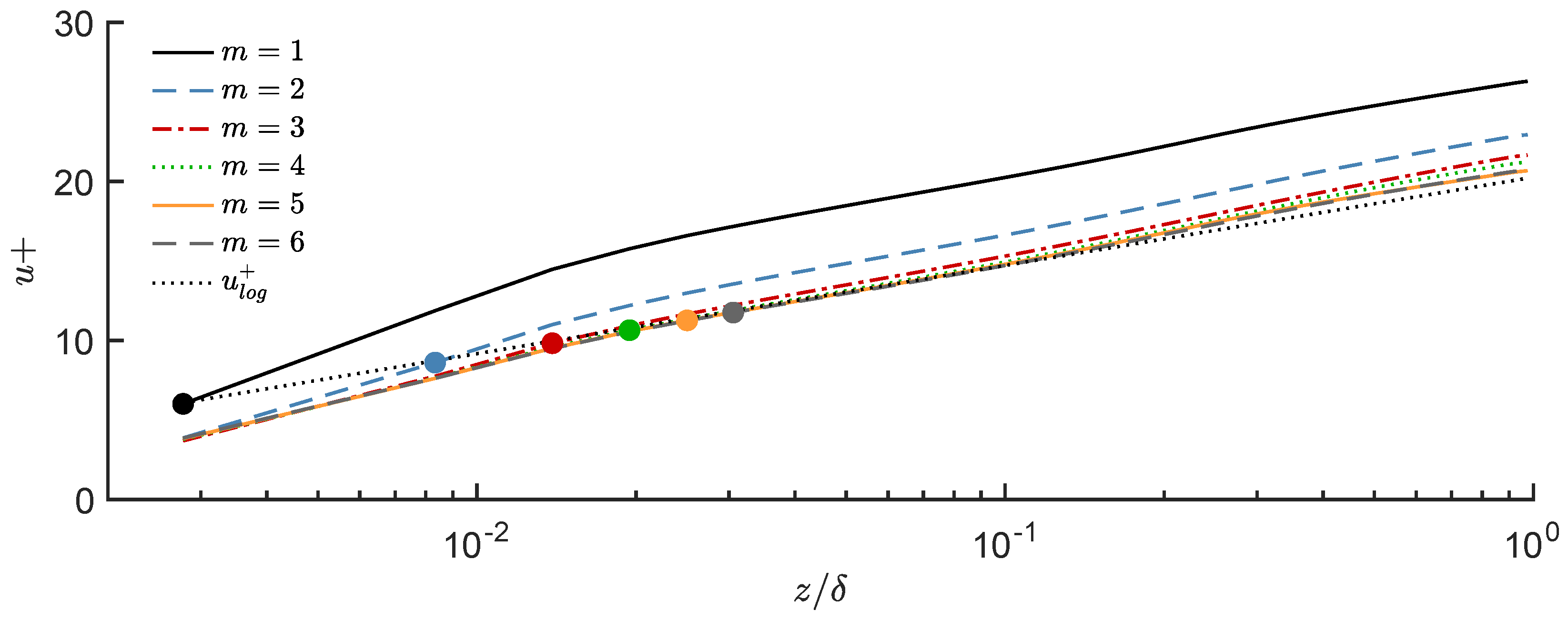
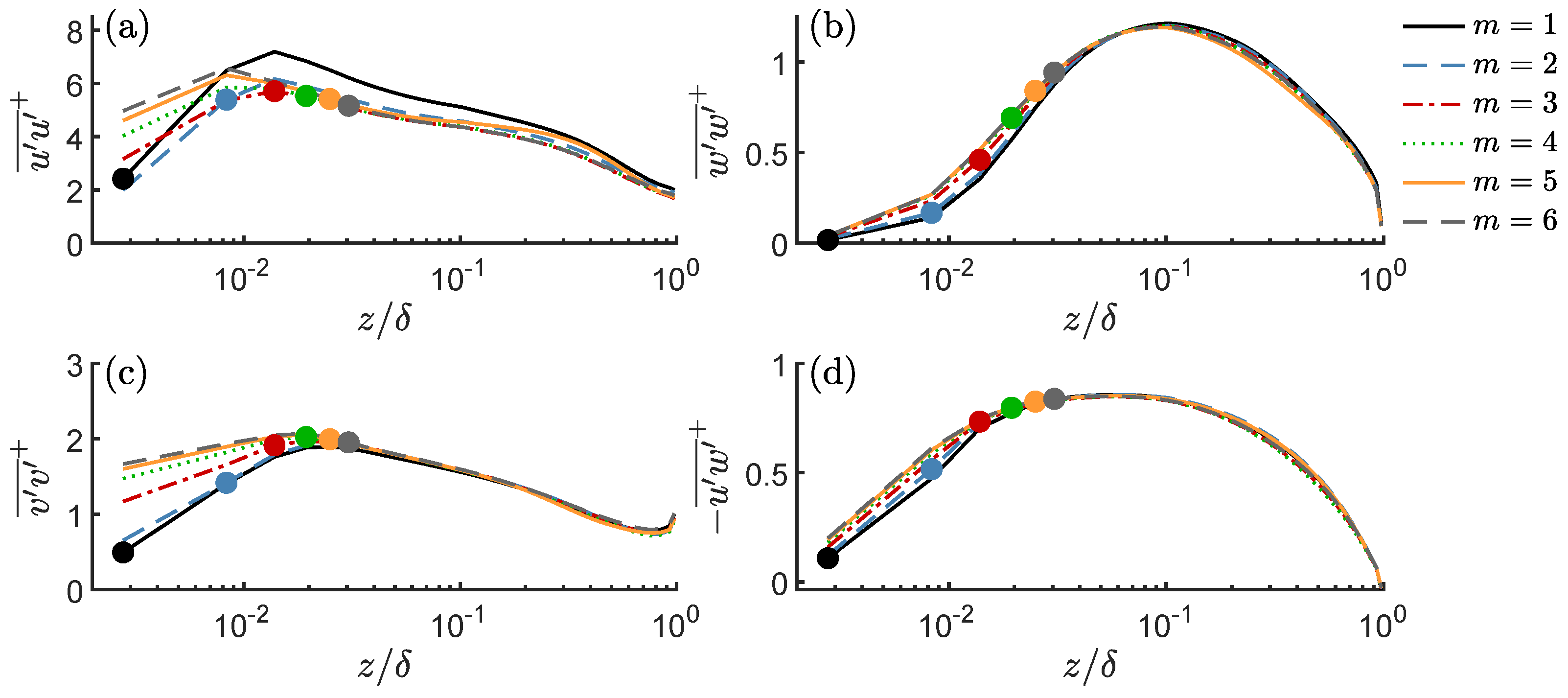
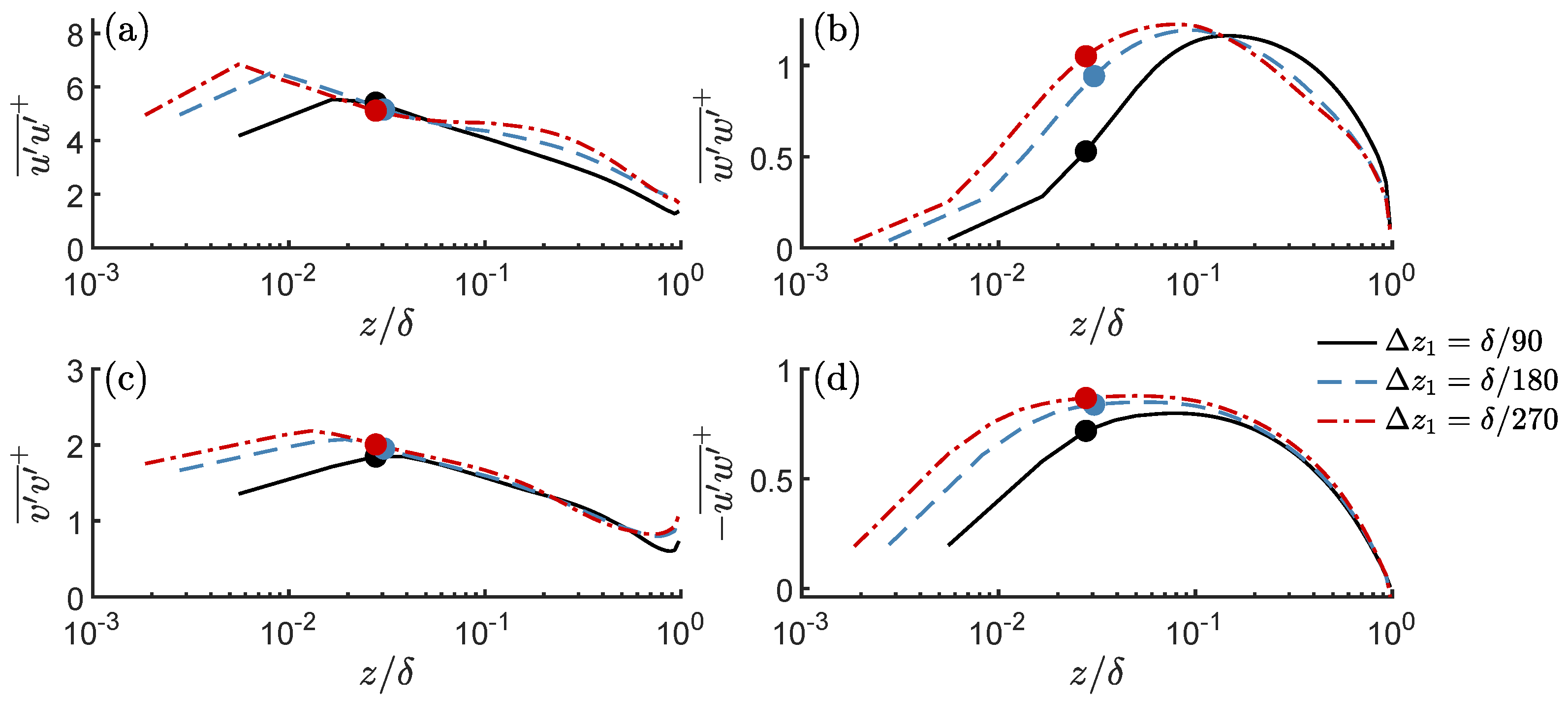

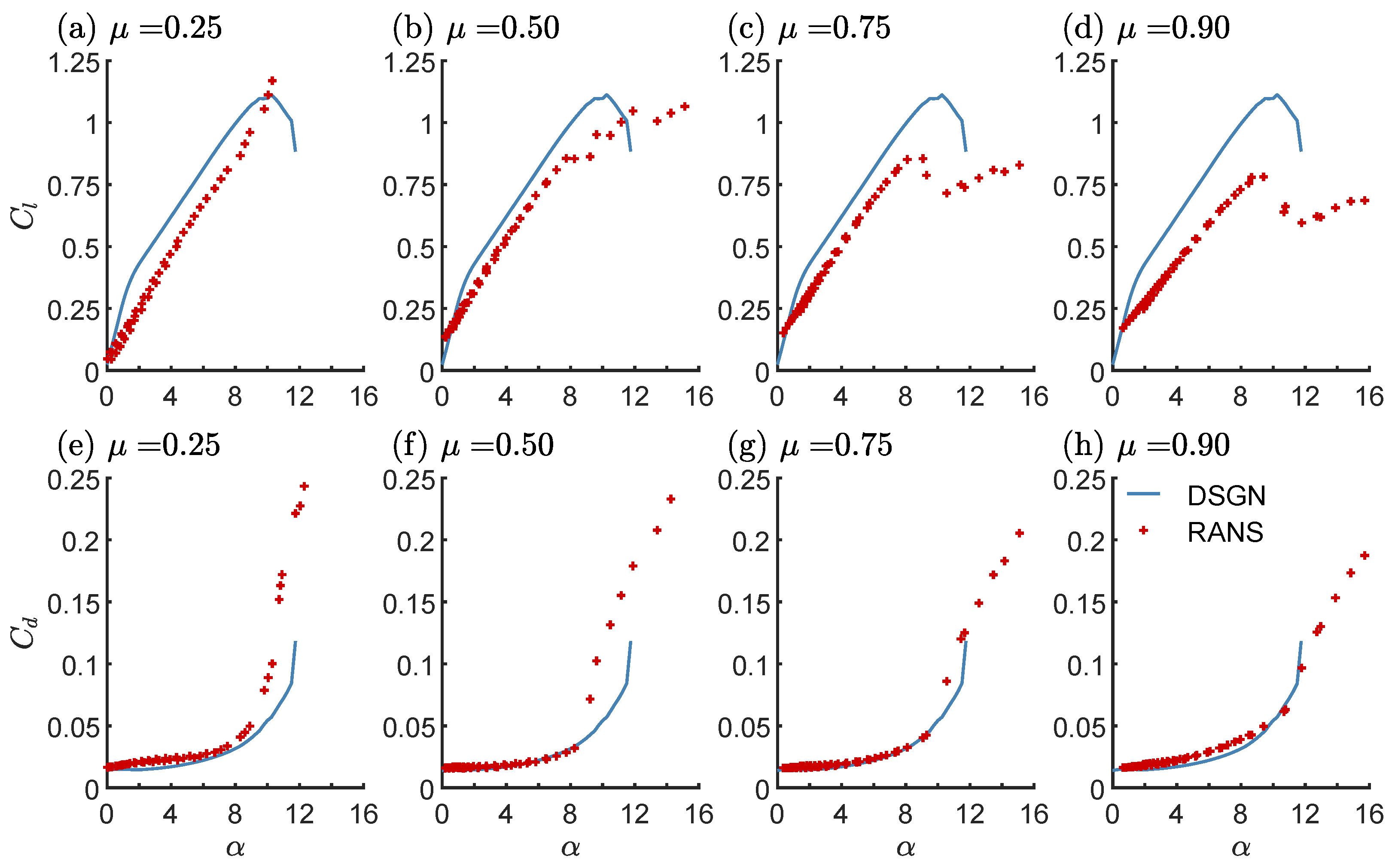
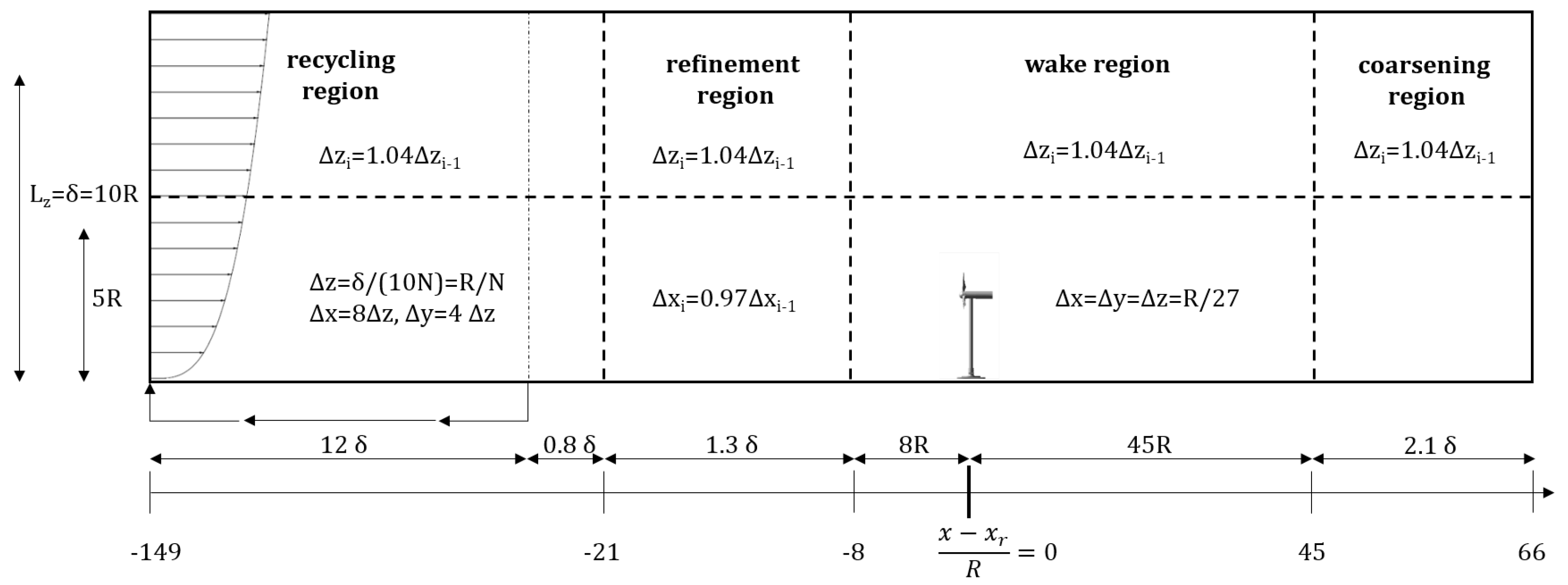

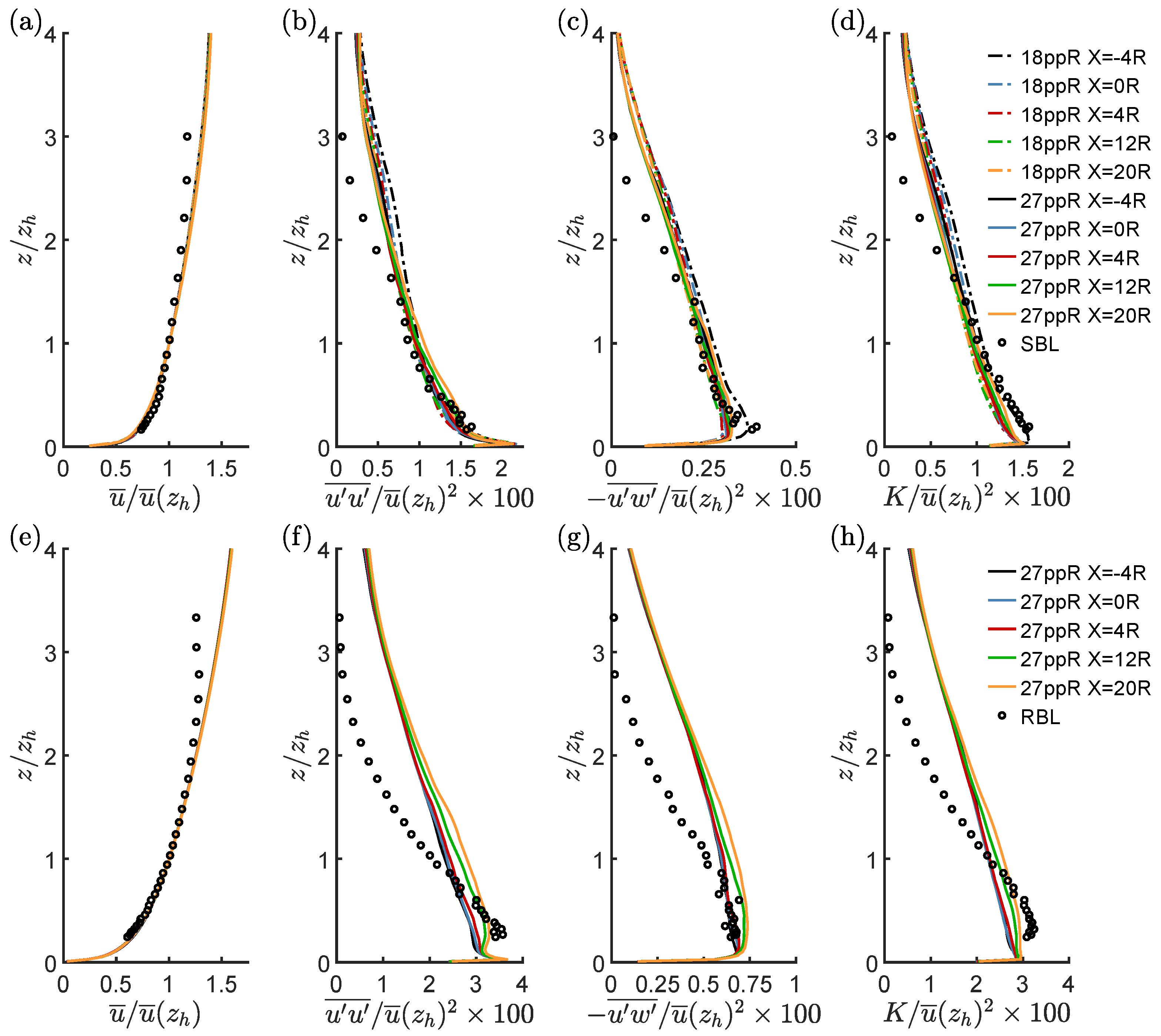

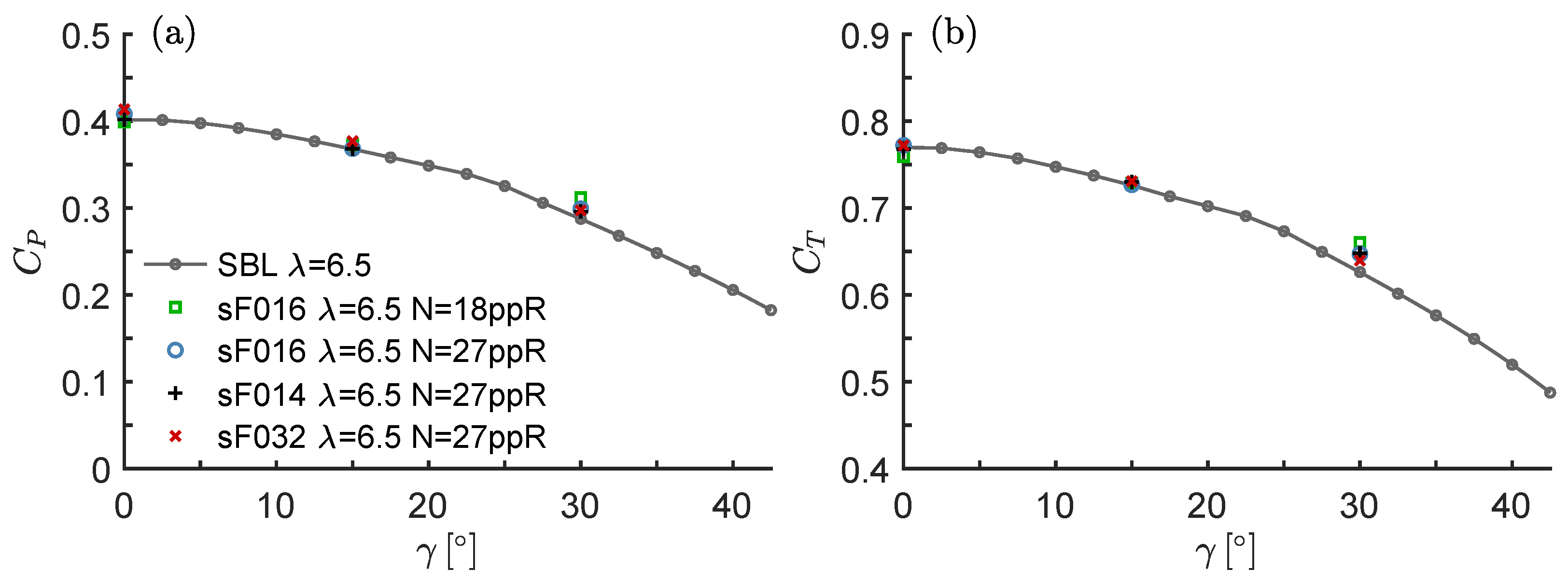
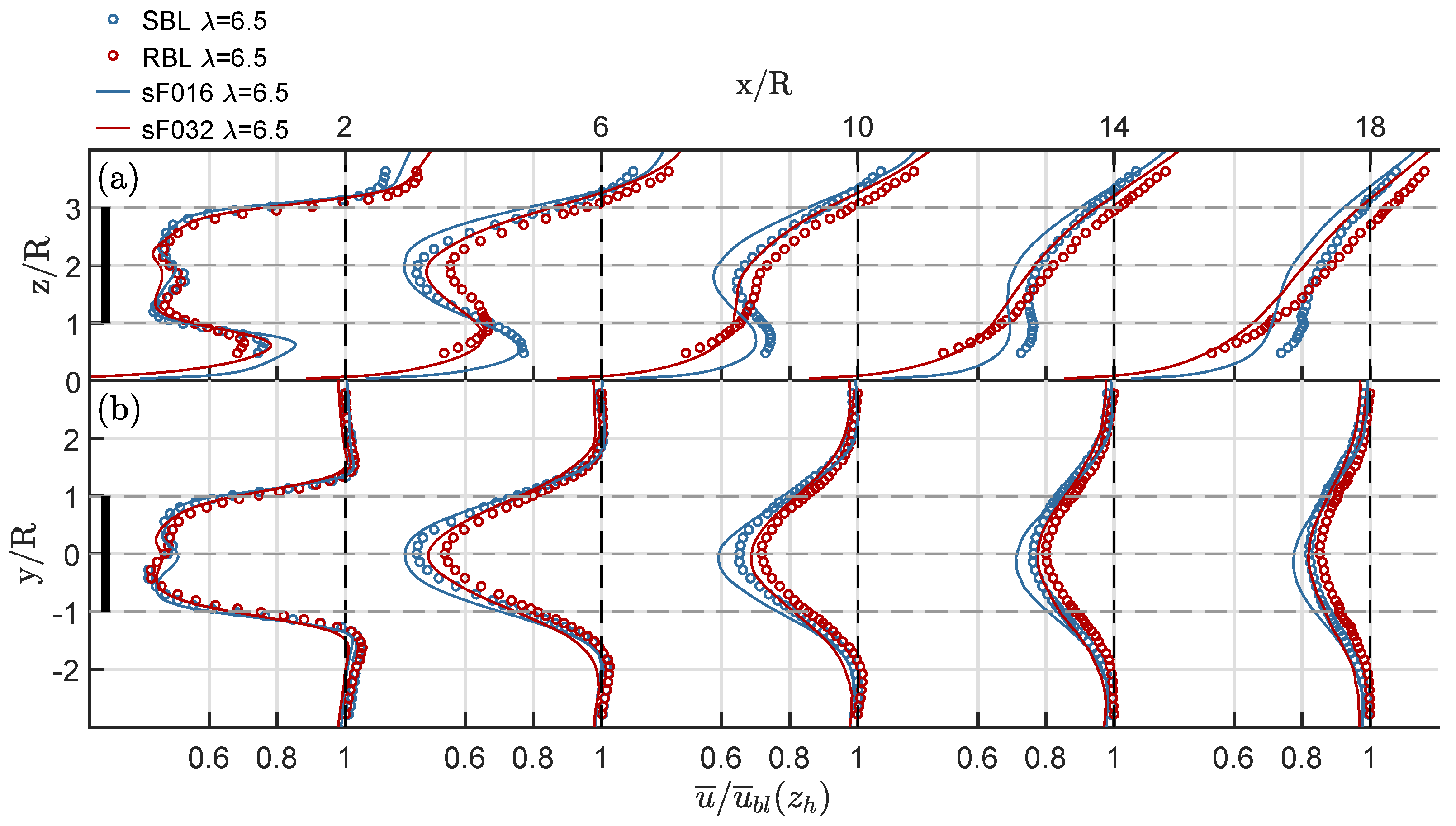
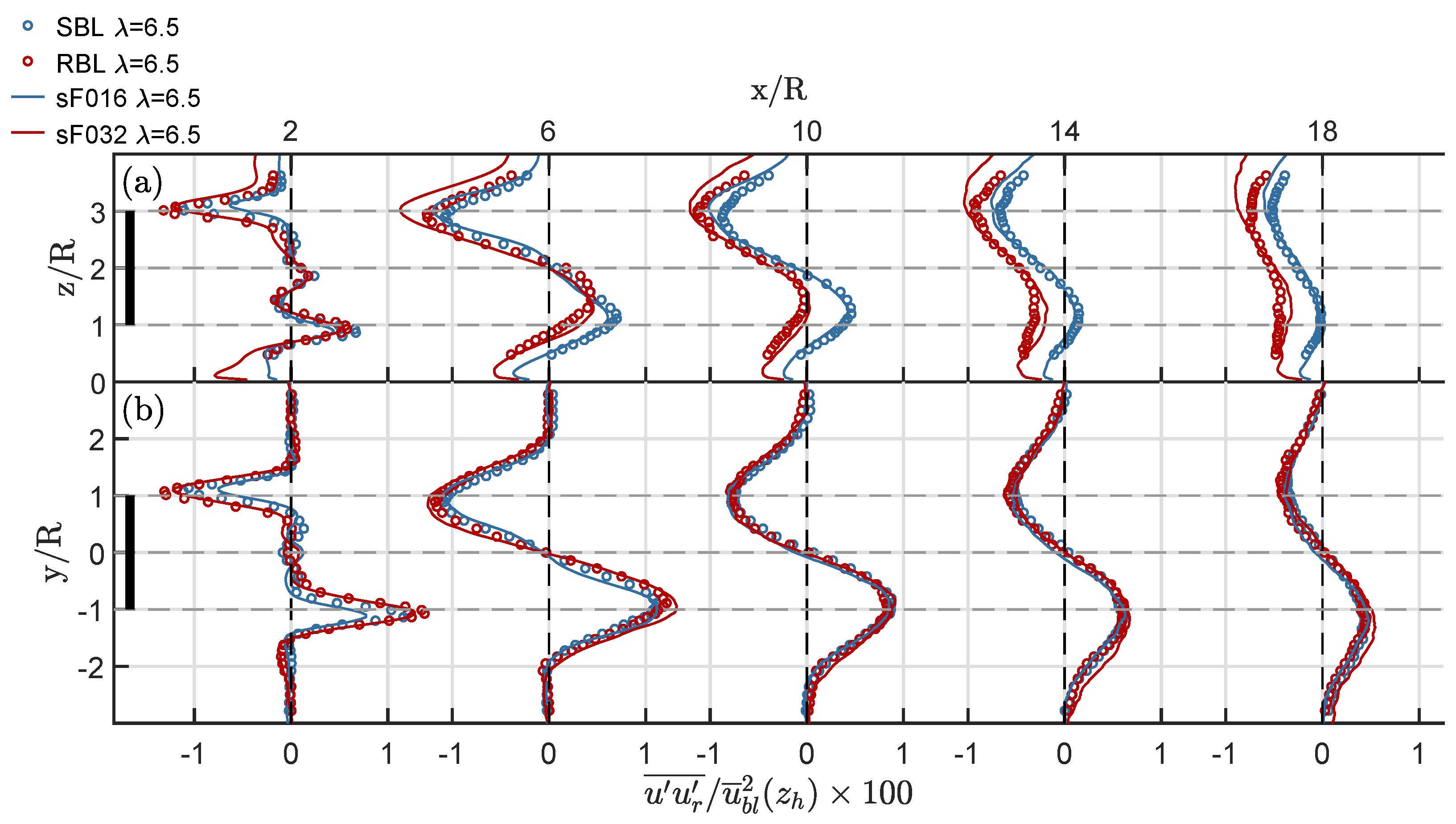
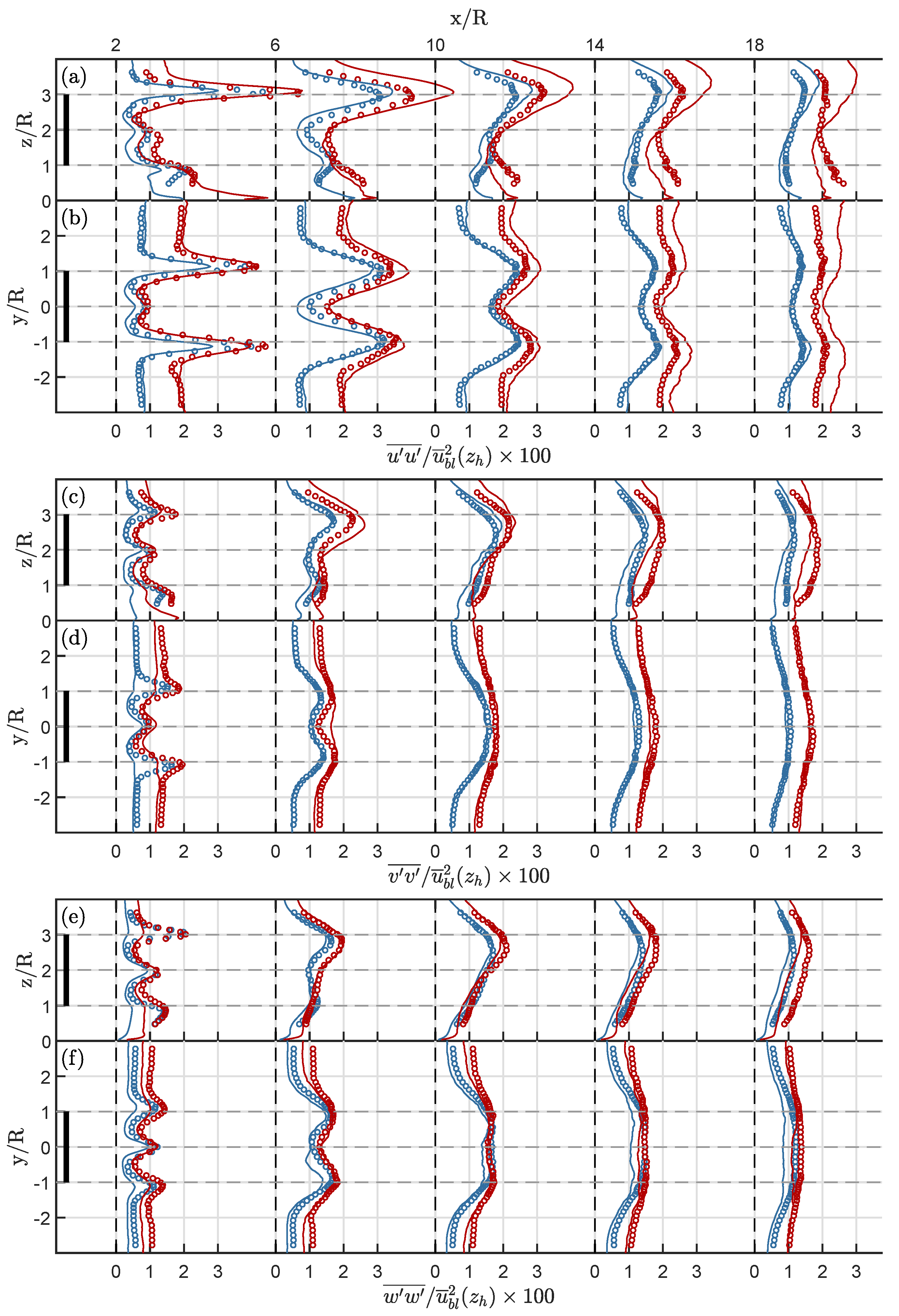
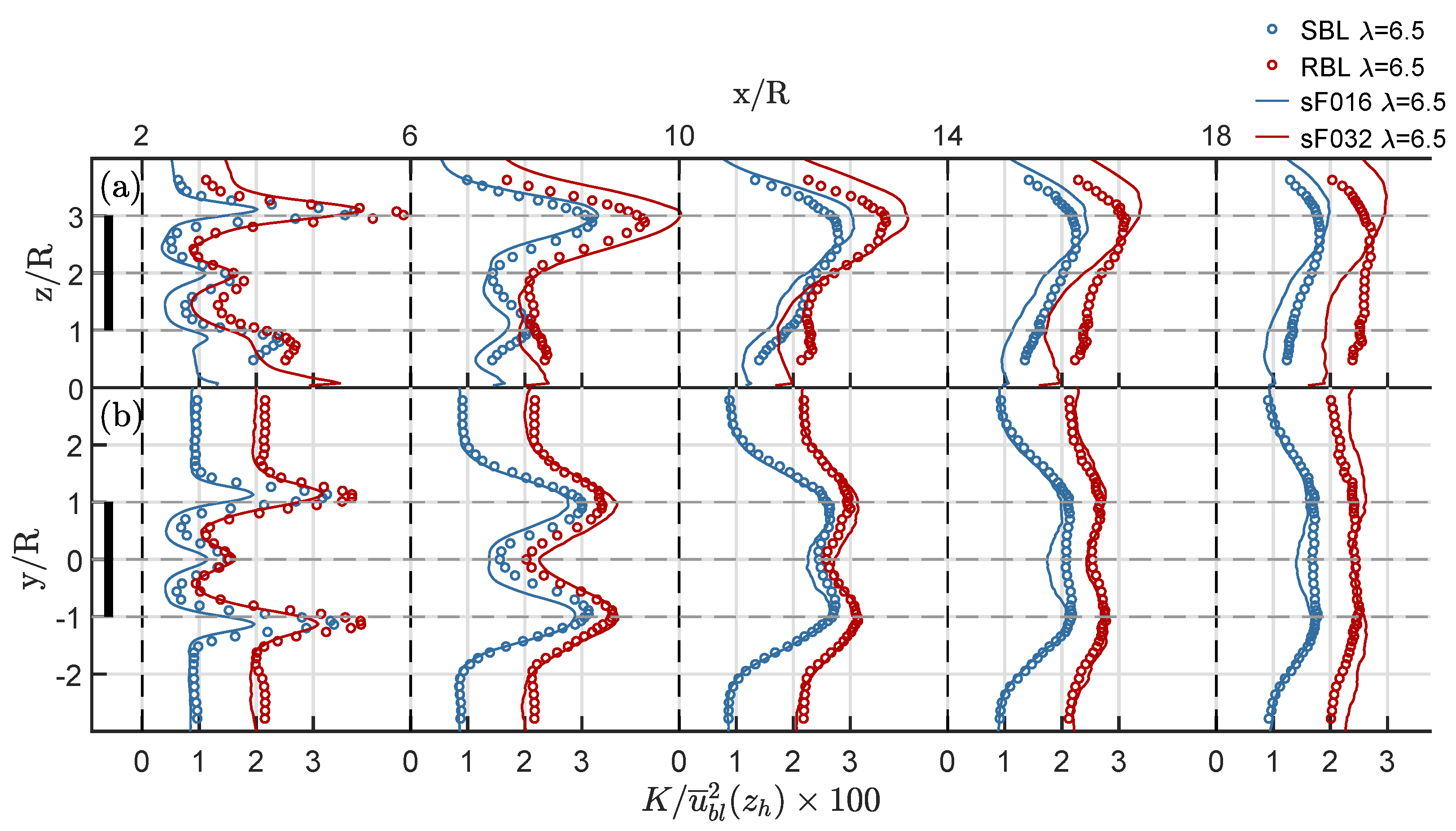

| Name | Acronym | [mm] | [m/s] | |||
|---|---|---|---|---|---|---|
| SBL | sf016 | 0.51 | 0.16 | 0.65 | 8.3% | 19 |
| RBL | sf032 | 5.06 | 0.32 | 0.89 | 13.8% | 190 |
Publisher’s Note: MDPI stays neutral with regard to jurisdictional claims in published maps and institutional affiliations. |
© 2022 by the authors. Licensee MDPI, Basel, Switzerland. This article is an open access article distributed under the terms and conditions of the Creative Commons Attribution (CC BY) license (https://creativecommons.org/licenses/by/4.0/).
Share and Cite
Stein, V.P.; Kaltenbach, H.-J. Validation of a Large-Eddy Simulation Approach for Prediction of the Ground Roughness Influence on Wind Turbine Wakes. Energies 2022, 15, 2579. https://doi.org/10.3390/en15072579
Stein VP, Kaltenbach H-J. Validation of a Large-Eddy Simulation Approach for Prediction of the Ground Roughness Influence on Wind Turbine Wakes. Energies. 2022; 15(7):2579. https://doi.org/10.3390/en15072579
Chicago/Turabian StyleStein, Victor P., and Hans-Jakob Kaltenbach. 2022. "Validation of a Large-Eddy Simulation Approach for Prediction of the Ground Roughness Influence on Wind Turbine Wakes" Energies 15, no. 7: 2579. https://doi.org/10.3390/en15072579
APA StyleStein, V. P., & Kaltenbach, H.-J. (2022). Validation of a Large-Eddy Simulation Approach for Prediction of the Ground Roughness Influence on Wind Turbine Wakes. Energies, 15(7), 2579. https://doi.org/10.3390/en15072579







